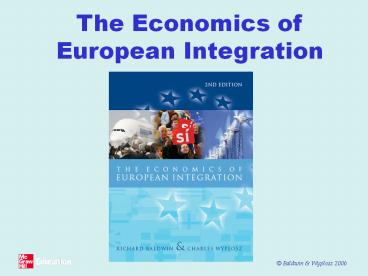Baldwin - PowerPoint PPT Presentation
Title: Baldwin
1
The Economics of European Integration
2
Chapter 7Growth Effects Factor Market
Integration
3
Growth Effects
- European leaders have long emphasised the
pro-growth aspects of European integration. - These operate in a way that is fundamentally
different from the way allocation effects
operate - They operate by changing the rate at which new
factors of production mainly capital are
accumulated, - Hence the name accumulation effects.
4
Verbal logic of growth
- Growth in income per worker requires more output
per worker. - Nation's labour force can produce more goods and
services year after year only if they have
more/better 'tools' year after year. - 'tools' means capital broadly defined
- physical capital (machines, etc.),
- human capital (skills, training, experience,
etc.) and - knowledge capital (technology).
- ERGO, rate of output growth is linked to rate of
physical, human and knowledge capital
accumulation. - Most capital accumulation is intentional and it
is called investment. - Thus European integration affects growth mainly
via its effect on investment in human capital,
physical capital and knowledge capital.
5
Verbal logic of growth summary
- European integration (or any other policy) ?
allocation effect ? improved efficiency ?
better investment climate ? more investment in
machines, skills and/or technology ? higher
output per person. - Medium run effects eventually fade out.
- Growth returns to its long-run rate.
- Long run effects raise long-run rate forever.
6
Some facts
Table 7-1 European Growth Phases, 1890-1992
7
Some facts
Growth in the WWII Reconstruction Phase.
8
Some facts
GDP per capita Rankings, 1950 and 1973 (1990
international dollars).
9
Some facts
Complete table
10
Solow diagram
- Show medium run growth effects in simple diagram.
- To simplify, start with whole EU as a single,
closed economy with fully integrated capital and
labour markets and the same technology everywhere.
11
Solow diagram
The inflow of new capital and how it varies with
K/L
Outflow of capital per L, constant depreciation
rate, delta
Assume fixed investment rate, s
12
Induced capital formation
Induced capital formation effect, i.e. medium-run
growth bonus
euros/L
GDP/L
E
Y/L
C
GDP/L
Y/Lc
Allocation effect
Y/L
d(K/L)
B
s(GDP/L)
D
s(GDP/L)
A
K/L
K/L
K/L
13
Integration induced investment rate rise
euros/L
Medium-run growth bonus
GDP/L
D
Y/L
Y/L
d(K/L)
B
s(GDP/L)
C
s(GDP/L)
A
K/L
K/L
K/L
14
Other MR growth effects investment rate.
Experience of Spain Portugal
15
Other MR growth effects investment rate.
Experience of Ireland
16
Other MR growth effects investment rate.
Experience of Greece
17
Long-term growth in Solow-like diagram
euros/L
GDP/L
Y/L
s(GDP/L)
A
d(K/L)
B
K/L
K/L Knowledge/L
18
Long-term growth impact of integration
Integration improves efficiency ? improves
investment climate ? higher investment rate (s
rises to s) ? faster growth (knowledge capital
accumulates more rapidly)
euros/L
GDP/L
s(GDP/L)
Y/L
s(GDP/L)
C
A
d(K/L)
B
K/L
K/L Knowledge/L































